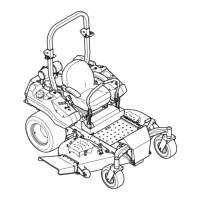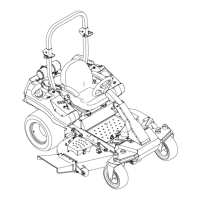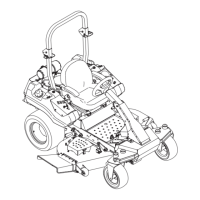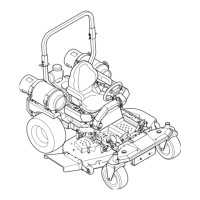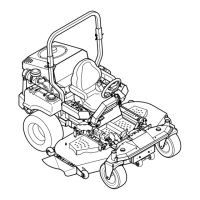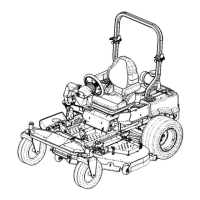Section 6— Maintenance & adjuStMentS30
a. Put blocks on each side of the opposite traction
wheel and jack up the tire that leaks about an inch
off the ground.
b. Loosen and remove the lug nuts and remove the wheel.
c. Mount a wheel and tire, replace the lug nuts, and
using a torque wrench, tighten them to 44-50 ft-lbs.
2. Front Tire
a. Set the park brake and block both rear tires and raise
the front tire so that it is an inch off the ground.
b. Loosen the flange lock nut and remove the spacer,
hex screw and two flat washers from the yoke. The
wheel will drop free.
c. Slip the hex screw, spacer and one flat washer
through one side of the yoke, then through the
wheel to the other side of the yoke.
d. Place a flat washer and a flange lock nut on the hex
screw and tighten to 44-50 ft-lbs to secure the wheel.
e. Lower the mower off the jack and continue mowing.
The wheel with the leaking tire should be inflated to 10-12 psi for
the rear tire and 20-25 psi for the front tire . Then place the wheel in
a large bucket of water. Carefully inspect the tire, rim and valve for
escaping air bubbles which indicate a leak. Mark each leak with a
yellow marking crayon and then deflate the tire to 8 psi and repeat
the inspection. If the leaks you find are pin hole size to ⁄” diameter,
the tire can be repaired. If the leaks are larger than ⁄” diameter, the
tire cannot be repaired. If the tire bead is damaged, the tire can be
repaired or the tire will have to be replaced.
Spindle Pulleys
Once a month remove the belt covers to remove any accumulation
of grass clippings from around the spindle pulleys and V-belt.
Clean more often when mowing tall, dry grass.
Pump Control
Blow out or clean out the pump control area under the floor pan.
Tractor Storage
If your tractor is not going to be operated for an extended period
of time (thirty days to approximately six months), the tractor should
be prepared for storage. Store the tractor in a dry and protected
location. If stored outside, cover the tractor (including the tires) to
protect it from the elements. The procedures outlined below should
be performed whenever the tractor is placed in storage.
1. Change the engine oil and filter following the instructions
provided in the engine manual.
WARNING! Never store the tractor with fuel in the
tank indoors or in poorly ventilated enclosures, where
fuel fumes may reach an open flame, spark or pilot
light as on a furnace, water heater, clothes dryer, etc.
2. Service the engine as instructed in the seperate engine
manual.
3. Engines stored between 30 and 90 days need to be treated
with a gasoline stabilizer such as STA-BIL® and engines stored
over 90 days need to be drained of fuel to prevent deterioration
and gum from forming in fuel system or on essential carburetor
parts. If the gasoline in your engine deteriorates during storage,
you may need to have the carburetor, and other fuel system
components, serviced or replaced.
WARNING! Fuel left in the fuel tank deteriorates
and will cause serious starting problems.
4. Remove the spark plugs and pour approximately one
ounce of oil into each cylinder. Crank the engine one or
two turns to spread the oil evenly on the cylinder walls.
Replace the spark plugs.
5. Clean the engine and the entire tractor thoroughly.
NOTE: Use of a pressure washer or garden hose is not
recommended to clean your tractor. This may cause
damage to electrical components, spindles, pulleys,
bearings or the engine. The use of water will result in
shortened life and reduce serviceability.
6. Sharpen the blades so that the mower will be ready to use
when needed.
7. Protect the metal surfaces. Repair scratches with the
appropriate touch-up spray paint. Brush a rust preventive
oil on any unpainted surfaces including the pulleys and
blades. (Be careful not to get any oil on the drive belts.)
8. Clean and fully charge the battery, then disconnect the
negative cable at the battery to prevent possible discharge.
Recharge the battery periodically when in storage.
NOTE: Remove the battery if exposed to prolonged periods
of sub-freezing temperatures. Store in a cool, dry location
where temperatures are above freezing.
9. Lubricate all lubrication points.
10. Inspect the hydraulic hoses, lines and fittings. Replace as
necessary.
11. Jack the mower up and store it on blocks to take the weight
off of the tires.
Removing The Tractor From Storage
1. Check the battery. Charge if necessary.
2. Lower tractor off blocks, and inflate the tires to the
recommended pressure.
3. Remove the spark plugs and wipe them off. Using the starter,
crank the engine to pump the excess oil out of the spark
plug holes. Replace the spark plugs and the ignition leads.
4. If drained before storing, fill the fuel tank with clean, fresh
gasoline.
5. Check the level of the engine oil in the crankcase and the
hydraulic reservoir tank.
6. Start the engine and allow to idle for a few minutes to
ensure engine is operating properly.
7. Drive the tractor without a load to make certain all the
tractor systems are functioning properly.
Adjustments
Seat
Refer to the Assembly & Set-Up section for instructions on
adjusting the seat.
Adjusting Drive Control Levers
Refer to the Assembly & Set-Up section for instructions on
adjusting the drive control levers.
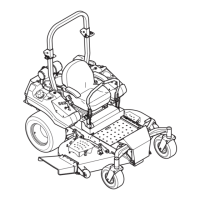
